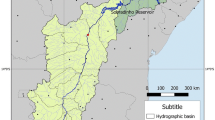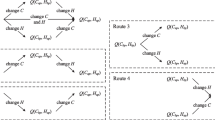Abstract
Quantifying the contributions of climate change (CC) and human activities (HA) to streamflow alteration is significant for effective water resources management. However, numerous studies fail to differentiate the individual impacts of various HA on streamflow. In this study, a comprehensive streamflow attribution framework that incorporates climate, vegetation, and water withdrawal (WW) was proposed. In this framework, traditional streamflow attribution methods such as statistical analysis (Double Mass Curve and Slope Change Ratio of Accumulative Quantity), elasticity (Budyko), and modeling simulation (Variable Infiltration Capacity and Long Short-term Memory) are employed to separate the influence of meteorological factors (MF) on streamflow. Subsequently, the impacts of WW on streamflow are assessed using global WW data. The Residual Analysis method is utilized to quantify the effects of vegetation alteration caused by both CC (Lcc) and HA (Lha) on streamflow alteration. To demonstrate the applicability of our proposed framework, two stations, Xianyang and Huaxian, located within the Weihe River Basin in Northwest China were selected as the case study area. The results demonstrated that compared to the baseline period (1961–1990), the average contributions of MF, Lcc, Lha, and WW to streamflow reduction during the variation periods (1991–2019) were as follows: for the Xianyang station, 26.0%, 13.5%, 30.9%, and 29.6% respectively; and for the Huaxian station, 28.9%, 5.5%, 17.7%, and 47.9% respectively. Additionally, during the variation periods, the contributions of CC and HA to vegetation variation were 30.5% and 69.5% respectively in Xianyang, and 23.7% and 76.3% respectively in Huaxian. The framework developed herein also provides a solution for quantifying the indirect effects of CC on streamflow through vegetation.









Similar content being viewed by others
Data Availability
Data will be made available on request.
References
Ahmed N, Wang G, Booij MJ et al (2022) Separation of the impact of landuse/landcover change and climate change on runoff in the upstream area of the Yangtze River, China. Water Resour Manag 36:181–201
Alehu BA, Bitana SG (2023) Assessment of climate change impact on water balance of Lake Hawassa Catchment. Environ Process 10:14
Bao ZX, Zhang JY, Yan XL et al (2021) Quantitative assessment of the attribution of runoff change caused by four factors in the Haihe River basin. Adv Water Sci 32:171–181
Fan JJ, Huang Q, Liu DF (2017) Identification of impacts of climate change and direct human activities on streamflow in Weihe River Basin in Northwest China. Int J Agric Biol Eng 10:119–129
Grill G, Lehner B, Thieme M et al (2019) Mapping the world’s free-flowing rivers. Nature 569:215–221
Gholami V, Khaleghi MR (2021) A simulation of the rainfall-runoff process using artificial neural network and HEC-HMS model in forest lands. J For Sci 67:165–174
Gholami V, Sahour H (2022) Simulation of rainfall-runoff process using an artificial neural network (ANN) and field plots data. Theor Appl Climatol 147:87–98
Gholami V, Sahour H, Khaleghi MR et al (2023) Evaluating the effects of vegetation and land management on runoff control using field plots and machine learning models. Environ Sci Pollut Res 30:31202–31217
Jiang SH, Wang MH, Ren LL et al (2019) A framework for quantifying the impacts of climate change and human activities on hydrological drought in a semiarid basin of Northern China. Hydrol Process 33:1075–1088
Jiang SH, Wang MH, Ren LL et al (2022) An integrated approach for identification and quantification of ecological drought in rivers from an ecological streamflow perspective. Ecol Indic 143:109410
Jin L, Duan KQ (2019) What is the main driving force of hydrological cycle variations in the semiarid and semi-humid Weihe River Basin, China? Sci Total Environ 684:254–264
Krajewski A, Sikorska-Senoner AE, Hejduk L et al (2021) An attempt to decompose the impact of land use and climate change on annual runoff in a small agricultural catchment. Water Resour Manag 35:881–896
Li ZH, Wang YM, Zhang HB et al (2022) Runoff response to changing environment in Loess Plateau, China: Implications of the influence of climate, land use/land cover, and water withdrawal changes. J Hydrol 613:128458
Liu Q, Li S, Zhou GF et al (2022) Attribution of nonstationary changes in the annual streamflow of the Weihe River using the de-nonstationarity method. Hydrol Res 53:407–418
Luo YY, Yang YT, Yang DW et al (2020) Quantifying the impact of vegetation ch anges on global terrestrial streamflow using the Budyko framework. J Hydrol 590:125389
Luan JK, Zhang YQ, Ma N et al (2021) Evaluating the uncertainty of eight approaches for separating the impacts of climate change and human activities on streamflow. J Hydrol 601:126605
Melo LS, Costa VAF, Fernandes WS (2023) Assessing the anthropogenic and climatic components in runoff changes of the São Francisco River Catchment. Water Resour Manag 37:3615–3629
Rani S, Sreekesh S (2019) Evaluating the responses of streamflow under future climate change scenarios in a Western Indian Himalaya Watershed. Environ Process 6:155–174
Sharifi A, Mirabbasi R, Nasr EMA et al (2021) Quantifying the impacts of anthropogenic changes and climate variability on streamflow changes in central plateau of Iran using nine methods. J Hydrol 603:127045
Swain SS, Mishra A, Chatterjee C et al (2021) Climate-changed versus land-use altered streamflow: A relative contribution assessment using three complementary approaches at a decadal time-spell. J Hydrol 596:126064
Sahour H, Gholami V, Torkaman J et al (2021) Random forest and extreme gradient boosting algorithms for streamflow modeling using vessel features and tree-rings. Environ Earth Sci 80:747
Wang SJ, Yan YX, Yan M et al (2012) Quantitative estimation of the impact of precipitation and human activities on streamflow change of the Huangfuchuan River Basin. J Geogr Sci 22:906–918
Wang MH, Jiang SH, Ren LL et al (2022) The development of a nonstationary standardised streamflow index using climate and reservoir indices as covariates. Water Resour Manag 36:1377–1392
Wang M, Zhang Y, Lu Y et al (2023) Attribution analysis of streamflow changes based on large-scale hydrological modeling with uncertainties. Water Resour Manag 37:713–730
Yan DH, Zhang X, Qin TL et al (2022) A data set of distributed global population and water withdrawal from 1960 to 2020. Sci Data 9:640
Yang XN, Sun WY, Li PF et al (2018) Reduced sediment transport in the Chinese Loess Plateau due to climate change and human activities. Sci Total Environ 642:591–600
Zhang LQ, Liu Y, Ren LL et al (2022) Analysis of flash droughts in China using machine learning. Hydrol Earth Syst Sci 26:3241–3261
Zhou ZH, Jin JX, Yong B et al (2022) Quantifying the influences of climate change and human activities on the grassland in the Southwest Transboundary Basin. China J Environ Manag 319:115612
Zhu YW, Wang HX, Guo WX (2021) The impacts of water level fluctuations of East Dongting Lake on habitat suitability of migratory birds. Ecol Indic 132:108277
Funding
This work was financially supported by the National Natural Science Foundation of China (U2243203, 51979069); the Fundamental Research Funds for the Central Universities (B200204029); the National Natural Science Foundation of Jiangsu Province, China (BK20211202); and the Research Council of Norway (FRINATEK Project 274310).
Author information
Authors and Affiliations
Contributions
Conceptualization: Shanhu Jiang; Yongwei Zhu; Methodology: Denghua Yan; Hao Cui, Ying Liu, and Menghao Wang; Funding acquisition: Shanhu Jiang, Liliang Ren, and Chong-Yu Xu.
Corresponding authors
Ethics declarations
Ethical Approval
Not applicable.
Consent to Participate
Not applicable.
Consent to Publication
Not applicable.
Competing Interests
The authors declare that they have no competing interests.
Additional information
Publisher's Note
Springer Nature remains neutral with regard to jurisdictional claims in published maps and institutional affiliations.
Rights and permissions
Springer Nature or its licensor (e.g. a society or other partner) holds exclusive rights to this article under a publishing agreement with the author(s) or other rightsholder(s); author self-archiving of the accepted manuscript version of this article is solely governed by the terms of such publishing agreement and applicable law.
About this article
Cite this article
Jiang, S., Zhu, Y., Ren, L. et al. A Complementary Streamflow Attribution Framework Coupled Climate, Vegetation and Water Withdrawal. Water Resour Manage 37, 4807–4822 (2023). https://doi.org/10.1007/s11269-023-03582-1
Received:
Accepted:
Published:
Issue Date:
DOI: https://doi.org/10.1007/s11269-023-03582-1




